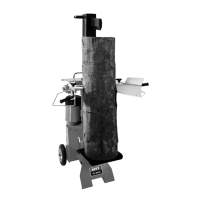Adjusting the table height, Fig. 5
Upper tabletop position, for logs up to 58 cm
Middle tabletop position, for logs up to 77 cm
Lower tabletop position, for logs up to 106 cm
Functional test
A functional test must be performed prior to each use.
Action: Result:
Press both handles down. Cleaver blade goes
down - to approx. 10
cm above the table.
Release one handle at a time Cleaver blade
remains in the
selected position.
Release both handles
simultaneously
Cleaver blade runs
back to the upper
position.
Check the oil level before each use, see chapter „Mainte-
nance“!
Splitting
Place the log on the log splitter table, hold the log firm-•
ly with the two control handles, press both operating
handles down simultaneously, once the cleaver blade
penetrates into the log, push the handles outward with
simultaneous pressure downward. This prevents pres-
sure from being exerted on the retaining plates.
Only cleave logs that are sawed straight off.•
Cleave the log vertically.•
Never split horizontally or crosswise.•
Wear safety gloves when cleaving the logs.•
Efficient operation
- upper position approx. 5 cm above the log
- lower position approx. 10 cm above the log
Start-up
Ensure that the machine is assembled completely and
correctly. Before each use, check:
the connecting cables for defects (splits, cuts, etc.),•
the machine for any damage,•
that all screws are tight,•
for any possible leaks in the hydraulic system and•
the oil level•
Venting, Fig. 7
Bleed the hydraulic system, before you put the log split-
ter into operation.
Loosen the vent cap A by a few turns, so that air can •
escape from the oil tank.
Leave the cap open during operation.•
Close the cap again, before moving the splitter, other-•
wise oil may leak.
If the hydraulic system is not vented, the trapped air will
damage the seals and thus the splitter!

